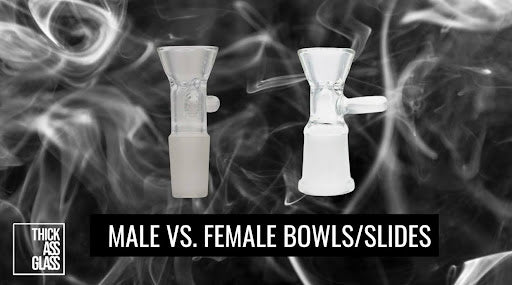If you’ve ever bought a bowl online, unboxed it, and found it wobbling awkwardly on your bong, or worse, not fitting at all, you know the problem.
Nine times out of ten, it comes down to not understanding joint gender.
And no, we’re not talking about anything biological or the target users for the bong. In glassware, "male" and "female" are purely mechanical terms: they describe how parts connect.
Image source - Sensi Seeds
A male joint inserts into another piece. A female joint receives something inside it. That’s it.
If you mismatch parts, say, try putting a male bowl into a male bong joint, you'll end up with something that doesn’t seat correctly. That kills airflow, ruins the seal, and puts stress on the joint, which is one of the most failure-prone areas of a bong.
Here’s where most people get tripped up: they assume gender matches like-for-like.
I’ve seen customers ask, “Do male bowls go with male bongs?”
The answer is the exact opposite. Male bowls go into female joints. Female bowls go over male joints. If you don’t know this, and you’re ordering accessories blind, you’re just one checkout click away from disappointment.
Once you understand how gender works in your setup, everything starts to click: airflow improves, accessories fit perfectly, and your whole smoking experience becomes more intentional.
Understanding Bong Gender: Male vs Female Explained
For something so essential to a bong’s function, joint gender often goes unexplained, leaving beginners guessing and veterans occasionally second-guessing.
But once you understand the design logic behind these terms, it becomes second nature. It’s not about style or preference, it’s about physics, fit, and function.
What Is a Male Bong Joint?
A male joint is a protruding glass stem designed to insert into another component.
If you hold your bong and see the joint sticking out, like a plug waiting for a socket, that’s a male joint. Accessories like bowls or bangers are meant to slide over this protrusion.
Male joints are most commonly found on dab rigs and smaller, travel-friendly setups.
Why? Because they reduce bulk and offer a more compact, streamlined form. For torching concentrates, a male joint lets you slip a female banger on top with minimal spacing and more control.
One advantage of male joints is their simplicity, but that comes with a tradeoff.
Since they’re exposed, they’re more susceptible to breakage. A light knock on a tabletop, and that joint could be history. So while male joints keep your rig tight and nimble, they also demand a little more care in handling.
What Is a Female Bong Joint?
A female joint is the inverse, it’s a recessed opening, designed to receive a male accessory.
The bowl slides inside the joint, creating a snug, stable fit. Female joints dominate flower bongs for a reason: they’re better suited to larger, more robust glassware and allow for a wide range of male slides, ash catchers, and other attachments.
Here’s the simplest way to remember it: male goes in, female fits around.
Think audio cables or plumbing, one end plugs into the other. Or, for a more colorful mental image: “two males clank awkwardly, two females smoosh and don’t connect.” The pairing has to be opposite or it doesn’t work, functionally or aesthetically.
How to Tell Which Joint You Have
Figuring out your bong’s joint gender doesn’t require a measuring tool or a technical manual, just a quick visual check.
If your bowl or downstem slides into the joint, your bong has a female joint. If it slides over the joint, then it’s a male joint. Once you’ve seen both styles side by side, it becomes impossible to confuse them again.
To check joint size, grab a dime. A dime has a diameter of 17.9mm, it will fit loosely into an 18mm joint, partially into a 14mm, and not at all into a 10mm. It’s not a perfect method, but it’s close enough to save you a return.
And yes, if you’ve already bought the wrong gender, you’re not out of luck.
Adapters exist to convert male to female or vice versa. Just keep in mind: changing your setup this way can affect airflow slightly. Sometimes it’s better to get it right from the start.
Why Does Bong Gender Exist Anyway?
At first glance, “male” and “female” joints might sound like arbitrary labels, but in the world of glass engineering, they serve a critical purpose.
Bong gender exists to optimize fit and function, not to complicate your shopping experience. It’s a solution born out of physics: joints need to connect seamlessly, create airtight seals, and allow for clean airflow with minimal drag. The male-female pairing ensures exactly that.
Glassblowers adopted this convention early on because it works.
A protruding male joint naturally fits inside a female joint, creating a snug, stable seal. It’s the same principle that makes plumbing and audio cables reliable. It’s not about aesthetics or gender symbolism, it’s just smart design.
Now, some folks ask, “Why even use gendered joints anymore? Isn’t that old-school?”
Fair question. But here’s the reality: manufacturers still follow these standards because they guarantee compatibility across pieces, brands, and accessories. Deviating from that system introduces chaos, and chaos doesn’t belong near a glass rig.
At Thick Ass Glass, we build within these standards not because they’re traditional, but because they work.
How Joint Gender Affects Your Smoking Experience
Once you understand the mechanics of bong gender, the next layer is how those differences actually show up when you smoke.
Believe it or not, the gender of your joint doesn’t just dictate what kind of bowl you can use, it affects how your entire setup performs, feels, and even how long it lasts.
Airflow Differences
Airflow is everything in a good bong.It's the difference between a smooth, flavorful pull and a harsh, restricted one.
Female joints, with their inset design, often provide a more stable platform for attachments. That added structural support means less wobble, which in turn maintains a more consistent seal, especially useful when you're stacking accessories like ash catchers or reclaim catchers.
Male joints, on the other hand, are typically slightly more open, which can result in a quicker pull with less resistance. That can be a plus for dabbers or anyone who likes compact setups.
But when you start adding heavier pieces, like a thick quartz banger or large bowl slide, that openness can lead to instability or even breakage if things aren’t perfectly balanced.
Durability & Risk of Breakage
From a structural standpoint, male joints are more exposed, and that makes them vulnerable.
All it takes is one small bump on a table corner or countertop, and that joint could chip, or worse, snap clean off. If you’ve got a travel rig or something that sees frequent handling, it’s worth considering how that exposure factors into daily use.
Female joints, by contrast, are recessed into the bong and offer a bit more protection. But there’s a tradeoff: because they’re enclosed, they can trap heat and resin more easily, especially if you’re using a torch or hitting it frequently.
Cleaning Concerns
This is where things get personal.
Ask any experienced smoker which joint is easier to clean, and opinions split fast. Many will tell you female joints are harder to scrub, especially when resin builds up deep inside the socket. The narrow space can make it feel like you’re chasing tar with a toothpick.
If you’re dealing with this, the fix is simple: ISO alcohol soaks, coarse salt, and pipe cleaners are your best friends.
For male joints, resin tends to build up externally, which makes cleaning faster but can also leave sticky residue where accessories slide on.
In either case, regular maintenance keeps your gear functional, and functional glass is happy glass.
What Goes with What? Solving the Compatibility Puzzle
Compatibility issues are one of the most frustrating, and most preventable, problems in the glass world.
It’s the kind of thing that turns excitement into confusion fast. But the rule is actually simple: a male joint requires a female accessory, and a female joint needs a male accessory. That’s it.
Let’s say you’re shopping for a new bowl.
If your bong has a female joint, you need a male bowl that inserts into it. If your rig has a male joint, you need a female banger or bowl that fits over it.
Sounds easy, right? Yet it’s the number one reason people end up with incompatible pieces.
In fact, we hear it all the time: “Why doesn’t this new bowl fit?” And the answer is almost always: “You’ve got the wrong gender.”
Now, if you’ve already made that mistake, don’t panic. You can still save your setup with an adapter.
Thick Ass Glass offers a full line of male-to-female and female-to-male adapters that bridge the gap between mismatched joints.
Just keep in mind that adding adapters may alter airflow slightly, and you’re stacking glass, which adds some risk.
Which One is Better, Male or Female?
This is one of the most common questions we hear, and the honest answer is, it depends.
There’s no universal “better” when it comes to joint gender. It’s about how you smoke, what kind of setup you prefer, and how much glass you’re stacking.
If you’re working with concentrates, a male joint is often the go-to.
Most dab rigs are designed with male joints to accommodate female bangers, which tend to sit more securely over the joint and allow for easy torch access. These setups are generally smaller, and male joints help maintain a compact footprint.
On the flip side, flower users lean toward female joints.
They’re more stable, better for larger bowls, and easier to upgrade with accessories like ash catchers or reclaim catchers. For big beakers or tall tubes, female joints are just safer. They distribute the weight better and reduce the chance of a bowl tipping or slipping off.
For those who travel or prefer discreet rigs, male joints offer simplicity. They keep things tight and lightweight, ideal for tossing in a case and heading out.
At TAG, we design around both genders because function isn’t one-size-fits-all. We give you the choice, so you can build the setup that fits your ideal.
Tips Before You Buy (or Replace) a Bowl or Downstem
Tip #1 Confirm Both Gender and Joint Size
Never assume. Always check that you know both the joint size (e.g., 14mm or 18mm) and the joint gender (male or female) of your bong and the accessory you’re buying. A 14mm male bowl won’t fit a 14mm male joint, gender must be opposite, and size must match exactly.
Helpful Resource -> Bong Bowl Sizes
Tip#2 Use Photos and Diagrams if You’re Unsure
If you're confused, take a photo of your bong’s joint and compare it to diagrams or listings from the retailer. A good product page should help you visually confirm whether your setup is male or female and what size you’re working with. A little time here saves frustration later.
Tip#3 Buy From Retailers That Show the Details
Choose a glass shop that gives you clear specs up front, not vague descriptions. At Thick Ass Glass, every listing specifies joint size and gender, and most include detailed visuals and adapter options so you know exactly what you're getting. That’s how you avoid guesswork, and wasted money.
Get the Right Fit for a Smoother Hit

Understanding bong joint gender isn’t trivia, it’s essential.
It’s the difference between a session that flows effortlessly and one that’s full of frustration. Whether you’re piecing together your first setup or upgrading to something more advanced, knowing the difference between male and female joints saves time, money, and headaches.
The truth is, no matter how thick the glass or how clean the pull, if your parts don’t fit together properly, you’re compromising performance. But once you learn how it all works, what fits with what, how gender affects airflow, and which setups are best for your needs, you take control of your smoking experience.
At Thick Ass Glass, we don’t just sell parts, we engineer them to work together seamlessly.
Browse our collection of precision-cut bowls, downstems, and adapters to get the fit, and the function, you deserve.


